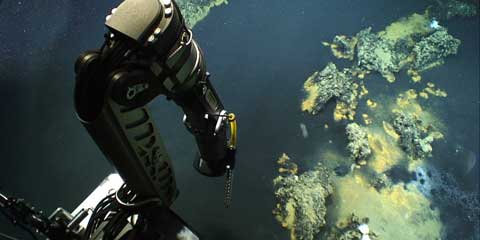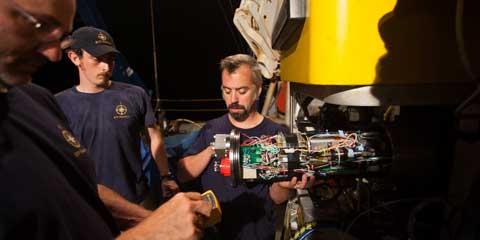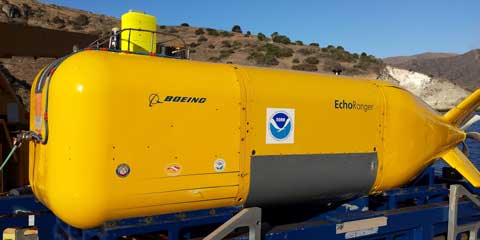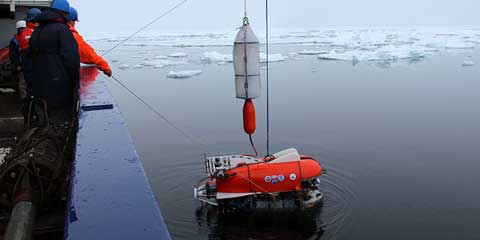
ROV Deep Discoverer uses its new temperature probe to learn more about the deep-sea environment around this brine pool discovered during the Gulf of Mexico 2014 Expedition. Credit: NOAA OER.
Technology to support deep-ocean exploration, research, and information collection has steadily improved but greater improvements are needed to significantly increase the pace, effectiveness, and scope of understanding our ocean world. Advancements will enable us to explore longer, deeper, and across greater spans while collecting and sharing new and more data. As always, these tools must withstand the rigors of depth, salinity, and pressure.
NOAA Ship Okeanos Explorer as a Technology Testbed
NOAA Ship Okeanos Explorer deploys a recently built two-vehicle remotely operated vehicle (ROV) system that has worked flawlessly—a record that is a testament to NOAA's Office of Ocean Exploration and Research's skilled ROV design, construction, and operations team of senior and early-career engineers and technicians who collaborate with academia, industry, and government partners.

With the assistance of the ROV pilots, Scott Wankel carefully installs the in situ laser spectrometer into its pressure housing mounted on ROV Hercules for deployment to the Kick ’em Jenny crater. Credit: K. Wood, Ocean Exploration Trust.
NOAA's Office of Ocean Exploration and Research (OER) continuously reviews opportunities to improve the operational capabilities and to advance technology. For example, ROV Deep Discoverer has 400 pounds of reserve buoyancy that could accommodate extra tools, sensors, or sample collection areas. Thought has been given to collecting samples during future expeditions, but that would take time away from pure exploration. For the Okeanos Explorer team—the only federal group that systematically explores the ocean—exploration time is limited and valuable. With that in mind, OER is very interested in working with scientists, engineers, and technicians to design, develop, test, and evaluate protocols and procedures for collecting voucher specimens that would add to baseline characterization products from exploratory expeditions. Further, OER has initiated and will continue discussions to develop new sensors and systems to conduct non-invasive sampling, in essence generating information typically derived from analyzing specimens in a laboratory without having to collect physical samples.
The ocean exploration community should consider Okeanos Explorer as a platform for testing new technology. Technology advancement is an important part of OER’s role, and the office is always interested in learning about such opportunities in proposals for grant funding or by other means.
Pilot Test of a Large AUV for Exploring Fish Habitat
OER led the development of NOAA’s agreement with Boeing to investigate new data collection methodologies to meet NOAA requirements.OER and the NOAA Fisheries Southwest Fisheries Science Center worked with Boeing to test Boeing’s large autonomous underwater vehicle (AUV), Echo Ranger, for a rockfish survey. Echo Ranger allows increased payload for sensors and batteries and longer mission endurance than most AUVs. The mission objective was to evaluate an AUV’s ability to conduct surveys independently or to augment a ship-based rockfish survey.

Echo Ranger is a large displacement AUV, 18.5 feet long, with a 150-nautical-mile range and maximum speed of six knots. The vehicle can be deployed from shore and allows increased payload for sensors and longer mission endurance. Credit: Boeing.
The test took place off Catalina Island in southern California and generated sonar maps of rockfish habitats and information about individual rockfish and aggregations of fish. The AUV simultaneously used a stereo camera to collect 3D optical imagery to identify the number and species of fish detected by sonar. Data are being analyzed for a potential follow-on mission in 2015.
Chemical and Isotopic Exploration of Deep-sea Environments
OER funded scientists from Woods Hole Oceanographic Institution to conduct the first-ever in-situ, real-time chemical and stable isotopic exploration of two unique seafloor sites in the Caribbean using a newly designed sensor package for measuring gases expelled from the seafloor. OER partnered with the Ocean Exploration Trust ![]() and leveraged an expedition by the Trust’s Exploration Vessel Nautilus.
and leveraged an expedition by the Trust’s Exploration Vessel Nautilus.

Nereid two-body system being deployed from the Polarstern during August 2014 sea trials. The mated-depressor and tow-body are lifted above the vehicle to facilitate a single point lift. Credit: C. German, WHOI.
Nereid Under-Ice AUV
OER contributed financial support to a mission that successfully tested Nereid, a robotic underwater vehicle for the ocean exploration community that provides a capability for real-time remote control as the vehicle conducts inspections and mapping surveys under the ice. The vehicle was developed by the Deep Submergence Laboratory at the Woods Hole Oceanographic Institution along with colleagues at Johns Hopkins University and the University of New Hampshire, supported primarily by a grant from the National Science Foundation. Nereid Under-Ice successfully completed its first field expedition from aboard the Alfred Wegener Institute’s ice-breaker, Polarstern. In addition to conducting engineering trials, the vehicle used biological sensors to study near-ice primary productivity.